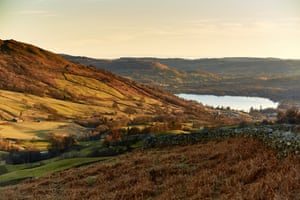The lakes mirror the fells and valleys
Maureen alerted me to Sian Cain’s Guardian article about Dorothy Wordsworth’s Grasmere Journal.
William and Dorothy Wordsworth moved to Grasmere in 1799, living in Dove Cottage until 1808. Dorothy’s journals document their quiet existence: daily walks, afternoons with mutton pies, William’s headaches. The siblings composed poems and letters as they walked through miles of hills and thickets; on occasion visited by friends like Walter Scott, Thomas de Quincey, Samuel Taylor Coleridge. In a 1797 letter, Coleridge described Dorothy’s taste as “a perfect electrometer — it bends, protrudes, and draws in at subtlest beauties and most recondite faults.” Consider her description of daffodils near Gowbarrow Park:
I never saw daffodils so beautiful. They grew about the mossy stones about and about them, some rested their heads upon these stones as on a pillow for weariness and the rest tossed and reeled and danced and seemed as if they verily laughed with the wind that blew upon them over the lake.
Sounds a good deal like William’s famous poem, doesn’t it. (Which is not, by the way, to hint that she was actually the better poet and just neglected because a woman. William at his best was a staggeringly good poet.)
Artist Georgie Bennett had not heard of Dorothy Wordsworth before being asked to illustrate a new edition of the Grasmere Journal for the Folio Society (“I remember learning a little about William at school, but I don’t think she was mentioned, which is a shame”) and had only been to the Lake District once before. Returning to see the landscapes described firsthand revealed new beauty in the landscape: “The most remarkable element has got to be the light – the light and colour across the Lake District is incredibly beautiful and the way the lakes mirror the fells and valleys is stunning. You can really see why [they] are so intimately associated with the Romantic period and why the Wordsworths chose this place to make their home … the whole mood of the landscape can change dramatically with the weather. Dorothy describes this changing of the seasons with such sensitivity.”
Her notebook is interesting, for sure, but there’s no particular reason she should be mentioned at school. Emily Dickinson, yes, but Dorothy Wordsworth, no.
But her notebook is interesting – she was a heroic walker. She writes about walking down to Windermere and back of an evening, which is a distance of something like 8 miles. She walked for pleasure, not just to fetch the post.
Bennett walked in Dorothy’s footsteps across the Lake District, through Grasmere village and to all the locations her journal describes: the church, the lake, the island, Dove Cottage. She explored Rydal – “where Dorothy would often go to send and receive letters” – as well as Grisedale Tarn, marked now as the spot where Dorothy and William last saw their brother, John.
“Dorothy lived a very independent and free life in Grasmere and she would spend her time walking for miles,” Bennett says. “Reading her journal, it is evident that she took great joy in experiencing and recording the world around her.” Bennett’s favourite passage is from near the end of the journal, where Dorothy describes a quiet moment looking over Grasmere with Mary, her brother’s wife:
I was much affected when I stood upon the second bar of Sara’s Gate. The lake was perfectly still, the sun shone on Hill and vale, the distant Birch trees looked like large golden Flowers – nothing else in colour was distinct and separate but all the beautiful colours seemed to be melted into one another, and joined together in one mass so that there were no differences though an endless variety when one tried to find out.
Photograph: Christopher Thomond for the Guardian


Really lovely. Grasmere, Windermere and Coleridge are all place names in a beautiful part of the South Island. All mountains, lakes and rivers. Clearly someone felt the link.
I’ve been to Windermere*, and would love to take a much more extended look. Meanwhile Google Earth gives an idea.
*The Cumbria one
I’ve been lucky enough to have been asked to speak at Grasmere a few times…it feels embarrassingly cliched, but I’ve rarely seen landscape so beautiful.
https://imgur.com/JvHMtS2.png
That was just from a random walk one morning before breakfast.
Golly. Thank you for that.
I was standing up there thinking ‘holy shit, those painters really did paint exactly what they saw.’ And of course as Dorothy says the view changes from minute to minute.
Guest, that was my exact thought when I saw your photo. In fact I looked pretty hard to be sure it wasn’t a photo of a painting.
@Rob, it’s literally a snapshot. One of many. About 20 minutes’ easy-ish walk from where I was staying (in other words, I didn’t have to work for it).